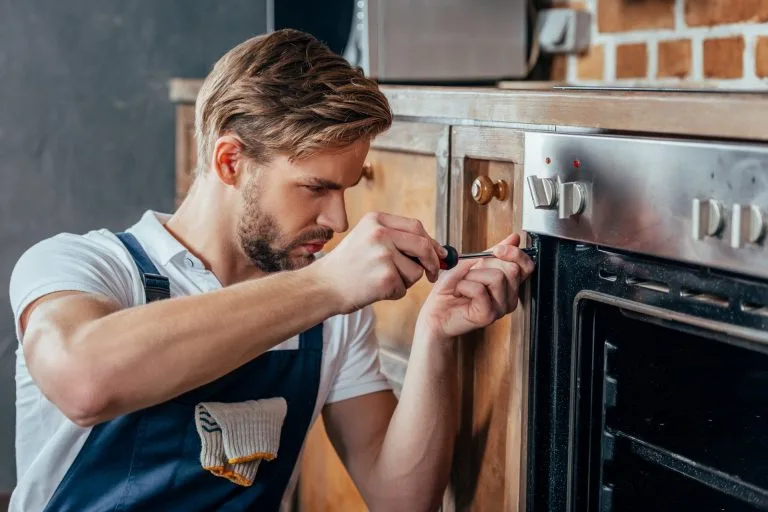Up To 60% OFF On Open Box Appliances
d
h
m
s
Up To 60% OFF On Open Box Appliances
SMS Appliances technicians are expertly trained stove repair in Brooks. When it comes to any issues with your stove, it’s best to have a professional take a look. Stoves often blow fuses and burnout sensors due to high temperatures. Using the latest technology that helps us diagnose and analyze problems, we can identify the issues and get your stove functioning as it should.
SMS Appliances Technicians are expertly trained to repair both gas and electric stove in Saskatoon. Stoves often blow fuses and burnout sensors and circuitry due to high temperatures.
With the latest technology and analysis we can identify things that keep your stove working, at the right temperature including control panels, coils, sensors and safety fuses. Our technician are trained for stove repairs electric (220 Volt) and gas models.
Once the issue is identified, full diagnose will be presented, service required and answer all of your questions.

When it comes to stove repairs in Brooks, we’ve become a household name to trust. We’re all about creating exceptional customer service experiences and fixing your appliance issues as quickly as possible, so you can get back to enjoying your home.

Stoves won’t turn on or ignite if there’s a problem with the oven surface element, igniter, infinite switch, or a bake or broil element. Bake oven elements glow red-hot when it’s functioning correctly. The heating element won’t glow red if it’s burnt out or if it’s visibly damaged.
What you can do before giving us a call is inspecting the heating element for holes or blisters. We can use a multimeter to check the bake element’s continuity to determine if we need to replace the part. When it comes to gas ovens that won’t turn on, the igniter is the likely culprit. We can check the state of your igniter and replace it as needed.
Stoves won’t turn on or ignite if there’s a problem with the oven surface element, igniter, infinite switch, or a bake or broil element. Bake oven elements glow red-hot when it’s functioning correctly. The heating element won’t glow red if it’s burnt out or if it’s visibly damaged.
What you can do before giving us a call is inspecting the heating element for holes or blisters. We can use a multimeter to check the bake element’s continuity to determine if we need to replace the part. When it comes to gas ovens that won’t turn on, the igniter is the likely culprit. We can check the state of your igniter and replace it as needed.
The control board on your stove is broken when the timer or the program settings are not working. The oven control board controls the temperature of the oven.
An electronic oven control panel controls the oven when its buttons are used to set the oven’s temperature. Diagnostic codes, also known as fault codes, are displayed when there is a problem with the stove.
If your oven is running too hot, it’s likely the temperature sensor or thermostat that’s defective. The thermostat is part of the main control panel, which regulates the broil and bake elements. It’s located on the back wall inside the oven near the broiler on the top wall.
For newer model ovens, check the manufacturer’s website or manual to determine the temperature sensor’s proper resistance.
When the stove igniter glows, but it’s not lit, there’s a broken electronic control, temperature sensor, surface igniter, or safety valve.
In gas ovens, defective igniters can often be spotted when the oven is turned on, and the igniter glows for more than 90 seconds without igniting the flame.
This indicates a weak igniter and is a sign that it needs to be replaced.
A common issue we’ve seen with newer oven models with self-cleaning functions is that sometimes the door won’t open even after the temperature drops. This can be caused by the malfunction of the oven temperature sensor. Sometimes the oven door won’t open because of the thermostat, door latch, or seal.
If your stove is overheating, it might be a thermostat or sensor problem. A technician can inspect and calibrate these components to maintain a safe cooking temperature.
If the display on your stove is not working, it may indicate a control board or wiring problem. A technician can diagnose and replace the malfunctioning components.
An improperly closing stove door can affect cooking efficiency. Hinges or seals may need adjustment or replacement to ensure a tight seal for optimal performance.













On All New Appliances

A delivery service you can depend on
Satisfied customers are our best ads
The highest level of security
5855 9 St SE, Calgary, AB T2H 1Z9
1914 St George Ave, Saskatoon, SK S7M 0K5
1348 Cornwall St, Regina, SK, S4R 2H5
1750 Gershaw Dr SW, Medicine Hat, AB T1A 5E1
124, 1 Street W
Brooks, AB T1R 1B5
Okotoks,
Alberta
Copyright 2023 © All Rights Reserved | SMS Appliances